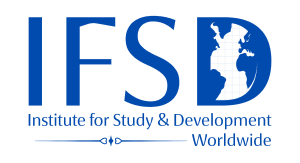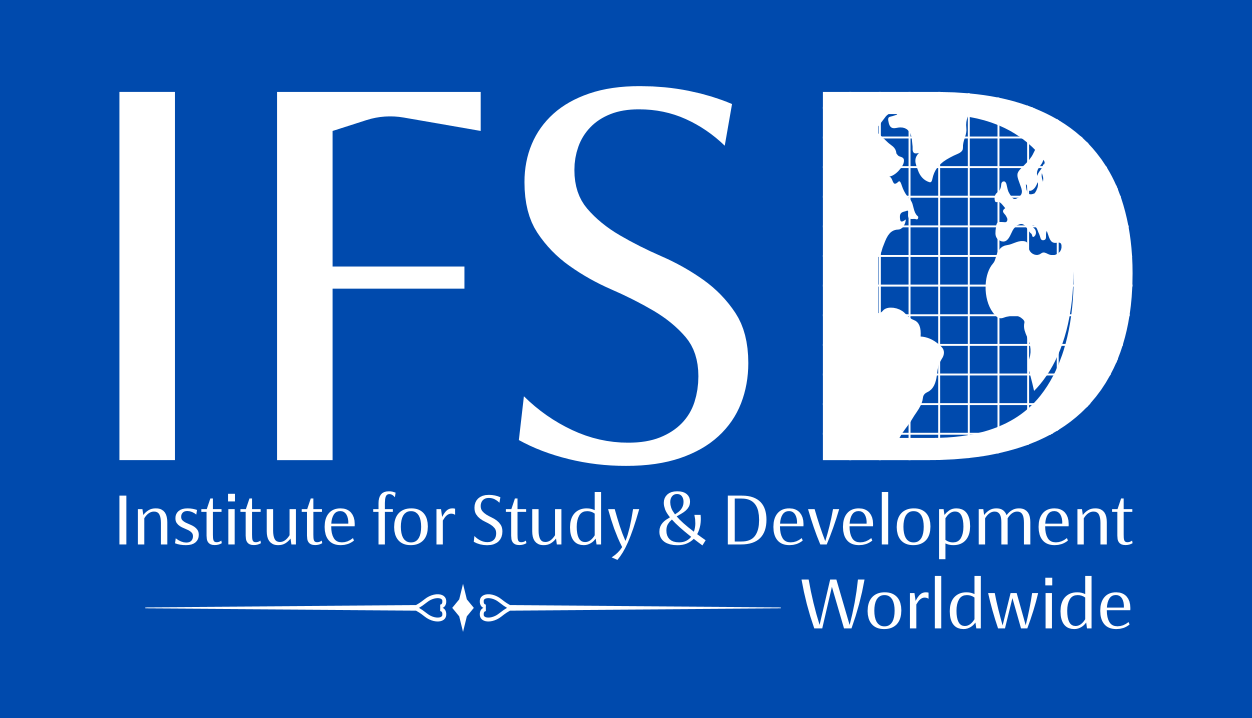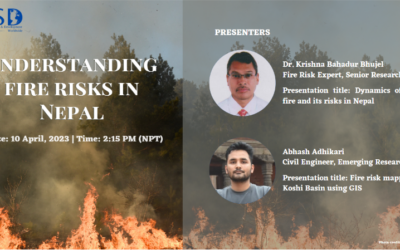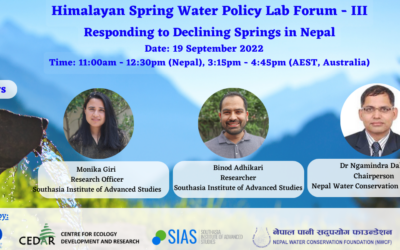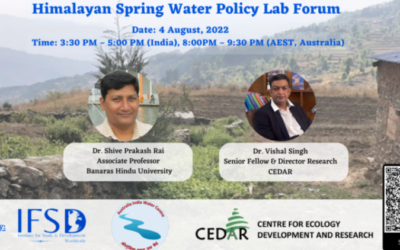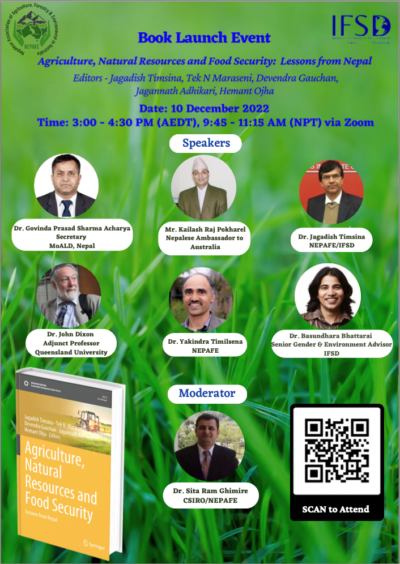
Overview
On 10 December 2022, the virtual launch event was held for the book titled “Agriculture, Natural Resources and Food Security: Lessons from Nepal” edited by Jagadish Timsina, Tek N. Maraseni, Devendra Gauchan, Jagannath Adhikari, and Hemant Ojha. A groundbreaking book which draws on the research of Nepalese diaspora agricultural professionals and helps us understand recent knowledge on issues and topics related to agriculture, livestock, and forestry systems across the three agroecological regions of Nepal, further also exploring the ways to tackle climate change impacts while considering gender, social equity, conservation and regenerative agriculture practices, and crop modelling.
The virtual book launch event was jointly organized by the Nepalese Association of Agriculture, Forestry, and Environment in Australia (NEPAFE) and the Institute for Study & Development Worldwide (IFSD). A total of 60 people attended the event from across Asia and Australia.
The event aimed to officially commence the release of the book as well to provide a better understanding and receive feedback on the book.
Session breakdown
- Opening remarks
- Book launch
- Book overview
- External comments on the book
- Q&A/Feedback session
- Brief remarks
- Closing remarks
Speakers
- Govinda Prasad Sharma, Secretary, The Ministry of Agriculture and Livestock Development (MoALD)
- Kailash Raj Pokharel, Nepalese Ambassador to Australia
- Jagadish Timsina, Editor-in-Chief, NEPAFE/IFSD
- John Dixon, Adjunct Professor, University of Queensland
- Yakindra Timilsena, NEPAFE
- Basundhara Bhattarai, IFSD
Moderator
- Sita Ram Ghimire, CISRO/NEPAFE
Opening remarks
Dr. Sita Ram Ghimire started the event with the acknowledgement of the country and introduced both the organizers (NEPAFE and IFSD). This was followed by a brief introduction of the speakers along with a general overview of the event agenda.
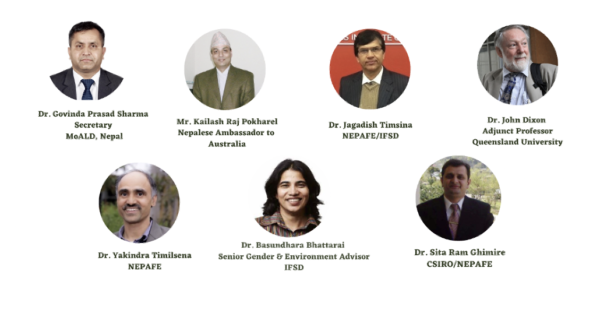
Book Launch
The book was jointly launched by secretary Dr. Govinda Prasad Sharma and his excellency ambassador H.E. Mr. Kaliash Raj Pokharel by providing congratulatory and brief remarks on the book.
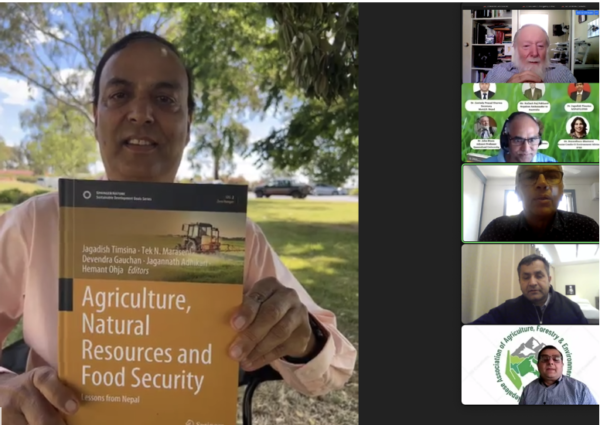
Dr. Govinda Sharma, Secretary, The Ministry of Agriculture and Livestock Development (MoALD) highlighted the book’s important contribution to sustainable development goals (SDGs) which will be really useful for policymakers, practitioners, and researchers. He particularly mentioned that the book’s four themes have properly covered a wide range important topics relevant to the theme. The four themes include: (a) Agriculture, horticulture, and post-harvest management; (b) livestock and fisheries; (c) forest ecosystems, community forestry, and agroforestry, and (d) crosscutting topics. He further explained how Nepal is suffering from serious food insecurity issues which is being further being worsened by policy issues mainly related to land and water use. As the book aims to help countries in the global South become food secure, he provided suggestions on the areas where research can be done to further add value such as exploring the pattern of land use change, understanding social capital in the agriculture sector, exploring private sector engagement, and reviewing water resources availability and its utilization trends. He concluded by stating that this book is indeed a huge contribution to effective development of policy making not in Nepal but also for countries with similar agro-climatic conditions across the world.
H.E. Mr. Kaliash Raj Pokharel, Nepalese Ambassador to Australia, mentioned that having worked previously in the aid cooperation sector with a specific focus on forestry and agriculture in the Ministry of Finance for over a decade, he found the book to be very relevant and promising in the context of sustainable development. He mentioned that each chapter provides specific recommendations based on the relevant topics within the four themes which excellently provides a strong basis for effective agriculture related policymaking and strategies for the next few decades. Among the many cross-cutting topics included in the book, he stated that he particularly liked introduction of the water-energy-food (W-E-F) nexus and the proper acknowledgement of critical agricultural actors: farmers, cooperatives, women organizations, and the government. While talking about future research areas, he highlighted three areas to focus on: human resources, cross border analysis, and education system.
From his perspective, a missing link found was on the human resource aspect in the agriculture sector. So, understanding how Nepal’s growing emigration is affecting the sector is very critical. With regards to our production, an important area he suggested focusing on was on finding out whether Nepal is a competitive advantage position in terms of production. If yes, what are the specific products and how can it be marketed internationally particularly to India. For this further analysis of India’s agriculture sector is also needed. He further highlighted the importance of directly linking both areas (human resources and production) with the education system. This is because to improve our agriculture sector for the benefit of the people and our economy, we need to have well-educated and trained people in the agriculture sector of Nepal. For this, we need to find the right education system to be adopted which properly enhances agriculture related knowledge.
He further stressed on the importance of disseminating our knowledge products for effective outcomes. How can we communicate our knowledge to a wider community? He shared his own ongoing efforts to do so by working with expert groups on various themes and potentially connect their research with think tanks in Nepal.
Both speakers concluded by congratulating all the editors and contributors of the book.
Book overview
Dr. Jagadish Timsina, editor-in-chief, welcomed the speakers and participants from different parts of the world. He started by acknowledging the suggestions from Dr. Sharma and Mr. Pokharel, further mentioning how the feedback will be useful for NEPAFE’s ongoing plan for another potential book project.
This was followed by an overview of the book in which he mentioned that 4 out of the 5 editors are based in Australia and 1 (Devendra Gauchan) is based in Nepal. Similarly, all of the editors are affiliated with NEPAFE and 3 out of the 5 are also affiliated with IFSD. So, it led to the two organizations to jointly organize the event. He then explained the structure of the book which includes 24 chapters grouped into 4 themes as mentioned by Dr. Sharma. A total of 65 contributors and 40 reviewers helped complete the book. To ensure proper quality of the content and citability, a rigorous peer-review process was also adopted as each chapter was reviewed by at least 2 –3 reviewers. He also acknowledged Dr. Bimala Rai Poudyal and Dr. John Dixon for their contribution for writing the foreword chapter.
This was followed by the motivation behind the book. He stated that the book emerged from the collective work of NEPAFE team which has been supporting the organization’s goal of advancing scientific cooperation between Nepal and Australia in the agriculture and environment sectors. NEPAFE provided all the contributors an excellent platform to share their concerns and visions from which the members decided that compiling cutting edge research in the form of an edited volume would be an important contribution to agriculture related policy and practice in Nepal. He then explained why the book is groundbreaking by highlighting that the book has adopted an integrated and cross-sectoral approach to problem diagnosis and solutions identification. Similarly, interdisciplinary approach was adopted to present research and practice-based knowledge. The book not only has presented update-to-date research on diverse topics of agriculture, livestock, forestry and its contribution to nutrition, food, and livelihood security in Nepal but efforts have been made to also connect the knowledge to global literature particularly South Asian literature. So, with this, the main aim of the book is to provide lessons to Nepal and other developing countries in the Global South. However, the concepts and problems mentioned in the book are global in nature and have global relevance which indicates the applicability of the book at the global scale.
He further explained that the book showcases recent studies and experimental insights of the authors who are actively involved in Nepal’s agriculture and natural resources management related policy and practice. So, all of them have thoroughly reviewed the related policy issues. He stated that chapters have demonstrated various components of the food systems including agronomy, horticulture, agrobiodiversity, soil science, plant health, seed supply and demand, food safety standards, quality seed development, post-harvest management, one health approach, aquaculture, trans immune system and socio-economics. All these topics have been researched to provide a proper foundation for food systems innovation in Nepal. The book also features a few internationally acclaimed practices such as urban agriculture, conservation agriculture, agroforestry, community forestry with the potential to make significant contribution not only to food security but also tackle climate change. Some of the cross-cutting chapters also explore gender and climate adaptation, W-E-F nexus mentioned by Mr. Pokharel, and crop simulation modeling. In fact, out of 24 chapters, 14 contains the word food security in their titles revealing the focus of the book on food and nutrition security.
This was followed by a summary of the lessons from the book, which included the following:
- Need of increased investment in research and development to develop climate resilient technologies and practices in cereals, fruit and vegetables, and fish and livestock
- Promotion of locally adapted species and varieties for further increasing their productivity and profitability such as citrus export potential to China
- Development of robust national seed system for seed security
- Conservation and multiplication of native, neglected, and underutilized species
- Effective soil fertility management and soil health improvement to achieve soil security
- Use of plant clinics or crop pest management and crop health
- Promotion of urban agriculture, conservation agriculture, and regenerative agriculture practices
- Correcting ineffective institutional arrangements to minimize food contaminants and toxins to maintain food quality and safety
- Adoption of multi-sectoral and collaborative one health approach to maintain animal, human and environmental health
- Protecting transhumance systems in mountains for economic and environmental sustainability
- Contribution of community forests in improving local livelihood and providing ecosystem services
- Sustainable harvesting of trees and forest products
- Promotion of integrated agroforestry and community forestry systems
- Need of integrated water-energy-food nexus approach in research and policy planning in achieving food water and energy security.
- Development and application of crop simulation modelling for closing crop yield gaps and mitigating climate change
- Need for gender and social inclusive technology development
He further stated that each chapter provides several practical recommendations for policymaking and implementation further contributing to SDGs. In fact, the book is also a part of the SDG series of Springer as various chapters have explicitly explored opportunities to enhance contributions to SDGs (1, 2, 3, 5, 8, 11, 12, 13, 14, and 15) with the major contribution being towards SDG 2 – zero hunger. He suggested readers to first read chapter 1 – introduction and overview as it has synthesized the main points from each chapter and provides the key recommendations of all the chapter. He also mentioned that despite the book being written and edited during the pandemic, when in person interactions were difficult, the situation still enabled authors and editors to see the effect of the crisis in Nepal’s food system.
He concluded by whole heartedly thanking all the editors, authors, reviewers, and publisher for their continuous commitment and contributions to complete the book. Further adding, that the editors are hopeful that this book will help achieve food security by contributing to scientific and policy debate and being useful to all organizations involved in agriculture including livestock, fisheries, and forestry related research in Nepal.
External comments on the book
Dr. John Dixon, Adjunct Professor at University of Queensland, started by congratulating all the editors and contributors of the book. He stated that he was really impressed by the multidisciplinarity of the editorial team: Jagadish Timsina – systems agronomy, Tek N. Maraseni – forestry, Devendra Gauchan – agriculture economics, Jagannath Adhikari – agrarian change, and Hemant Ojha – geography and policy. This reminded him of the need to pull together and combine knowledge bases across different farming systems and across various commodities in Nepal.
He mentioned that while reading the book, he was amazed the progress made by Nepal compared to the 1980s when he lived in Nepal undertaking a national farming systems survey. Currently, the increased area of forest and the return to labor has been amazing. However, declining soil fertility, existing yield gaps, and food insecurity of rural people are still major challenge. So, this book will definitely be a valuable resource in this matter and it should be made widely available. He emphasized that the real work of the team (editors and authors) has just begun as they now have to find ways to communicate, share, and inform policymakers, researchers, and other influencers about the implications of this analysis for Nepal. With more than 60 plus recommendations on different themes from horticulture to economics, the team must also strategically find to ways to practically implement it in the real-world context.
Going back to Dr. Timsina’s remarks on the motivation behind the book, he noted that the editors were perplexed by the level of food insecurity in Nepal despite relatively having rich resources and being placed in a unique position with potential competitive advantages in nature-based products. In this matter, he asked a reflective question: How in such a situation and capacity within Nepal and the context of Nepalese professional diaspora, how is it that projection in this book still anticipate food insufficiency in 2030 and even worse in 2050? In this matter he further suggests that there could be an alternative scenario to these projections where Nepal not only becomes self-sufficient but also supports neighboring countries (India and China) with specialized food products. This he says is achievable only if we do not solely focus on the natural and biophysical dimensions but also complement them with a deeper analysis of institutions and incentives for all actors: farmers, women, men, youth, value chain, and rural communities.
He further mentioned how spill overs to other countries can be organized systematically, in such a way that Nepal is the recognized as the origin and sharer of lessons from development experience. He said that he always shares that the story of how the concept of community forestry originated in Nepal. This was further spread when he was working at Food and Agriculture Organization (FAO) where he chaired the agroforestry group. During that time community forestry spread globally and that has been a major contribution from Nepal to other countries. So, now he asks why not in terms of nature-based ecosystem services? Why not in terms of the lessons that can be drawn from this book? Because there is a lot of potential in this area specific to Nepal. There is a total of 65 million hectares of highland farming system across Asia, indicating this to the editors he mentioned the importance of engaging with national and regional institutions such as ICIMOD in order to create spill over deliberately with other countries across Asia. Similarly with 34 million hectares of high-altitude farming which also is the prime ICIMOD target system, lesson from the region and the book can be shared with other countries.
He concluded by conveying appreciation to all the editors and contributors of the book and wished good luck for the future development of Nepal.
Q&A/Feedback session
Dr. Jagadish Timsina moderated the session by thanking all the previous speakers for their suggestions which will be useful moving forward with their potential book project.
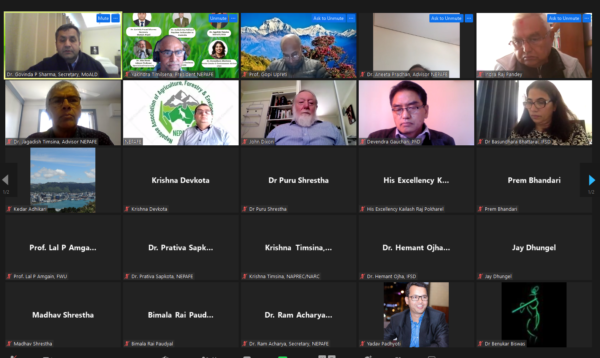
On exploring how Nepal can reach food self-sufficiency
Dr. Ganesh Thapa who was a reviewer for the book, started by congratulating all the editors and contributions and stated that this book will be very useful to policymakers, students, and other stakeholders in and beyond Nepal. He then mentioned the important question raised by Dr. Dixon on whether Nepal can be self-sufficient in food production and even export to neighboring countries. He mentioned about being associated with the publishing a similar book also with Springer Link two years on Nepal called Agriculture transformation in Nepal. In the book, they did highlight an alternative approach in which Nepal can be self-sufficient. He further indicated that the current scenario of high imports in Nepal is not at all sustainable. So, he suggested that for the upcoming book project the editors should also focus on how this alternative approach (food self-sufficiency) can be achieved.
On sharing lessons from Nepal regionally and globally
Dr. Ganesh Thapa further supported Dr. Dixon’s statement of sharing lessons from Nepal. He emphasized that the book has important knowledge and lessons which can be shared both regionally and globally. However, a suggestion he provided on this matter was also to include indigenous knowledge systems as we are mostly informed by science-based knowledge. In Nepal, indigenous communities have played a critical role in managing the food systems but oftentimes their knowledge and practices are not properly acknowledged. So, he stated that there is a lot of scope to combine both science-based and indigenous-based knowledge to better provide evidence-based recommendations.
On the team behind the book and the need to build new partnerships between diasporic communities and international research organizations for development
Dr. Hemant Ojha acknowledged the feedback received from previous speakers and the comprehensive book overview provided by Dr. Timsina. As one of the editors, he supported Dr. Timsina’s previous statement of the book emerging out of the research work done by NEPAFE team. He reiterated that this book did not emerge from a university or international research organization but from a small team of Nepalese diasporic experts based in Australia. This itself is a very interesting dimension specifically when it comes to adding important questions and perspectives because in such situations, the role of diasporic communities is critical.
He further mentioned that there are many associations and organizations working towards building the partnerships through research and community engagement. From his recent month-long visit to Nepal, he shared his experience of visiting community forest and rural landscape sites. He saw rapid change happening in the landscape for which we need to confront important questions which requires new research and partnerships. Specifically, with regards to partnership between diasporic communities and Australian research organization such as ACIAR and DFAT who have international mandate in areas of international development. So, there is a huge potential for expand collaboration to confront even more important questions some of which has been raised by previous speakers.
On sharing one’s experience on completing the chapter
Dr Madhav Shrestha author of the chapter titled Sustainable fisheries and aquaculture for food and nutrition security in Nepal, shared his experience completing the chapter during the pandemic. He mentioned that it indeed was a rigorous peer-review process with continuous revisions and virtual meetings. He expressed his satisfaction in successfully completing the chapter and is hopeful that it will provide critical insights for policymakers and researchers on the aquaculture sector.
On engaging with policymakers
Dr. Puru Shrestha who has been involved in developing projects through partnerships with diasporic communities for the past 8 years started by mentioning that he was very impressed by the remarks provided H.E. Mr. Kailesh Raj Pokharel. His remarks provided a proper review of the book and the gaps that needs to be addressed in the future. He further stressed on the importance of the involvement of the government in development projects. For this, he emphasized on the need to go beyond publishing research by finding ways to engage with policymakers. So, the next important part for the editors and contributors is focusing on how the book can be made accessible to important stakeholders for its proper utilization.
Brief remarks
Dr. Yakindra Timilsena, president of NEPAFE started by expressing his gratitude towards the speakers, editors, and contributions for their contributions towards this launch event and book publication. Supporting Dr. Ojha’s emphasis on building partnerships with diasporic communities, he stated that it certainly is an asset needed for development and knowledge transfer to Nepal. He then briefly talked about NEPAFE by mentioning that the association consists of members with various expertise within the agriculture sector. He further welcomed participants to write blogs on their expertise which can further largely contribute to building partnerships.
Closing remarks
Dr. Basundhara Bhattarai, senior gender and environmental advisor at IFSD also authored a chapter titled Agrobiodiversity management for gender-equitable adaptation to climate change: investigating the gendered roots of vulnerability in the Nepal Himalayas. She started by expressing appreciation to the speakers for their contributions towards the book launch specifically their feedback on the book. Speaking from her experience with writing the chapter, she shared how overwhelming the process can be when publishing a book. She acknowledged Dr. Timsina, for this continued dedication and support for completing the book. Referring to Dr. Dixon’s inspiring comment on how the real work for the contributors has just begun, she agreed to it by stating that it comes at right time as we find ways to disseminate the knowledge to the wider community. She concluded by once again thanking all the editors and contributors on behalf of the organizers for publishing the book and mentioned that the real journey has just now started to reach a wider audience.
How to cite this report – Gurung, P. and Sapkota, S. (2022). Book launch event: A report summarising the event proceedings and outcome. The Nepalese Association of Agriculture, Forestry, and Environment in Australia (NEPAFE) and Institute for Study and Development Worldwide (IFSD)
Download PDF version of the report.
